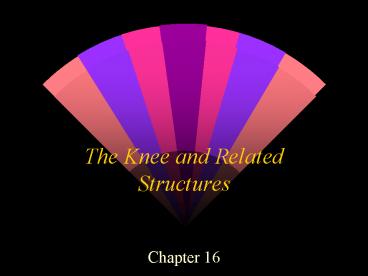The Knee and Related Structures - PowerPoint PPT Presentation
1 / 19
Title:
The Knee and Related Structures
Description:
Popliteal fossa. Fat pads / plica. Nerves. Blood vessels. KNEE ALIGNMENT DEVIATIONS ... Determine swelling by manually moving the fluid in the knee from one ... – PowerPoint PPT presentation
Number of Views:104
Avg rating:3.0/5.0
Title: The Knee and Related Structures
1
The Knee and Related Structures
- Chapter 16
2
(No Transcript)
3
KNEE ANATOMY
- Bones
- femur
- fibula
- tibia
- patella
- Articulations
- tibiofemoral
- patellofemoral
4
ANATOMY cont.
- Menisci
- Medial meniscus
- Lateral meniscus
- Blood supply (3 vascular zones)
- Versus hyaline cartilage
- Ligaments
- Medial collateral - MCL (deep superficial)
- Lateral collateral - LCL
- Cruciates - ACL PCL
5
ANATOMY cont.
- Joint Capsule
- Synovial Capsule
- Knee musculature
- quadriceps group
- hamstrings group
- iliotibial band
- gastroc, gracilis, sartorius, popliteus,
plantaris - Patellar tendon
6
ANATOMY cont.
- Additional Knee Structures
- Bursa
- Popliteal fossa
- Fat pads / plica
- Nerves
- Blood vessels
7
KNEE ALIGNMENT DEVIATIONS
- Patellar malalignments
- Genu valgum
- Genu varum
- Genu recurvatum
- Q angle
8
KNEE INJURIESand CONDITIONS
- FRACTURES
- DISLOCATION
- CONTUSIONS
- SPRAINS
- MENISCUS TEARS
- the Unhappy Triad
- SYNOVIAL PLICA SYNDROME
9
INJURIES cont.
- OSTEOCHONDRITIS DISSECANS
- PATELLAR DISLOCATION/SUBLUX
- CHONDROMALACIA
- OSGOOD-SCHLATTERS DISEASE
- LARSEN-JOHANSSON
- JUMPERS KNEE
- ILIOTIBIAL BAND SYNDROME
- ARTHRITIS - DJD
10
KNEE INJURY EVALUATION
- HISTORY AND MECHANISM (MOI)
- How did it happen / what happened?
- previous injury or problems
- acute or chronic problem
- Sounds heard?
- Returned to play?
- PHYSICAL EXAM - SYMPTOMS
- Pain, swelling, ROM, etc.
- Areas of pain localized if possible
11
EVALUATION cont.
- SPECIAL TESTS
- Valgus / Varus test
- Drawer test
- Lachmans test (alternate Lachmans?)
- McMurrays test
- ADDITIONAL SPECIAL TESTS
- X-ray and/or MRI
- KT-1000
- Apleys, Slocums, Rotary instability tests?
12
Evaluation of Swelling
- Sweep Test
- Determine swelling by manually moving the fluid
in the knee from one side of the knee to the
other. - Ballotable Patella Test
- Downward pressure on the patella is applied. A
positive test is indicated by the patella
bouncing back to its original position.
13
Tests for ACL Instability
- Drawer Test
- Lachmans Test
- Alternate Lachmans Test
- Modified Lachmans Test
- KT 1000 Arthrometer
14
Tests for PCL Instability
- Posterior Drawer Test
- Godfreys Test
- Uses gravity to extenuate the posterior sag as
noted by observation. Flex knees bilaterally to
90 degrees.
15
Tests for Rotary Instabilities
- Clinically, athletes suffering from rotary
instabilities will complain of the knee going
out. - Slocum Drawer for Rotary Instability
- Drawer test with int. ext. rotation
- Pivot Shift Test
- Crossover Drill
16
Tests for Meniscal Tears
- Meniscal injuries may often be in combination
with other injuries to the knee, or they can be
isolated. Immediate diagnosis is often
difficult, but fortunately not an emergency. - McMurrays Test
- Apleys Compression/Distraction Test
17
Additional Conditions
- Infrapatellar Fat Pad
- Bursitis
- Other Patello-femoral conditions
- Extensor Mechanism problems
- Osgood-Schlatters - Iliotibial band
syn. - Larsen-Johansson disease - Pes Anserine syn.
- Jumpers knee - Collapsing
knee - Patellar tendon rupture
18
Knee Rehabilitation
- General Conditioning
- Weight Bearing
- Knee Joint Mobilization
- Flexibility
- Muscular Strength
- Neuromuscular Control
- Bracing
19
Summary
- Knee Injuries are of Increasing Concern
- Most common injuries are sprains of MCL, ACL, and
LCL meniscal tears, and patello-femoral
problems. - Prevention Seems to be Difficult
- Braces have limited effect
- Evaluation and Management of Knee Injuries
Experience - Rehabilitation Following Injury will Vary

